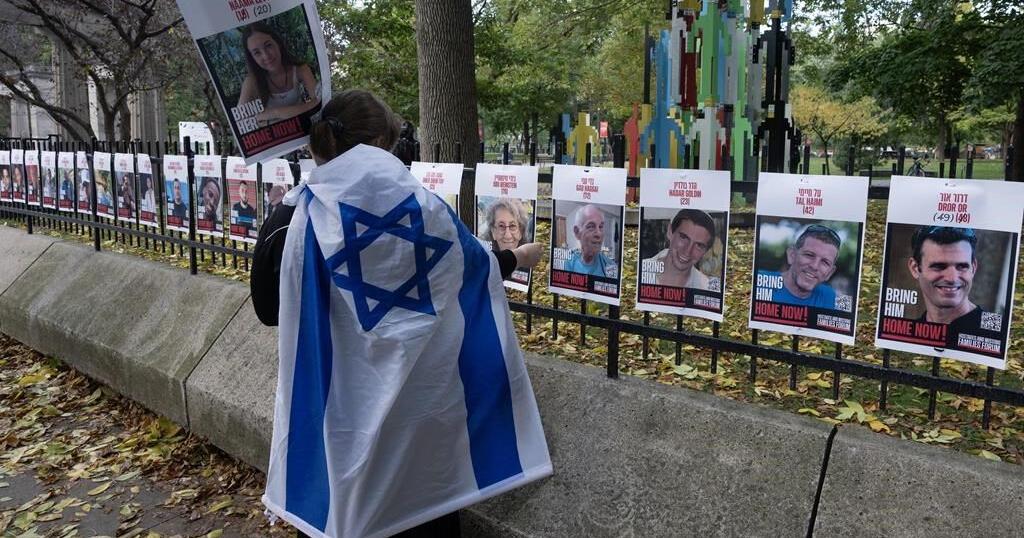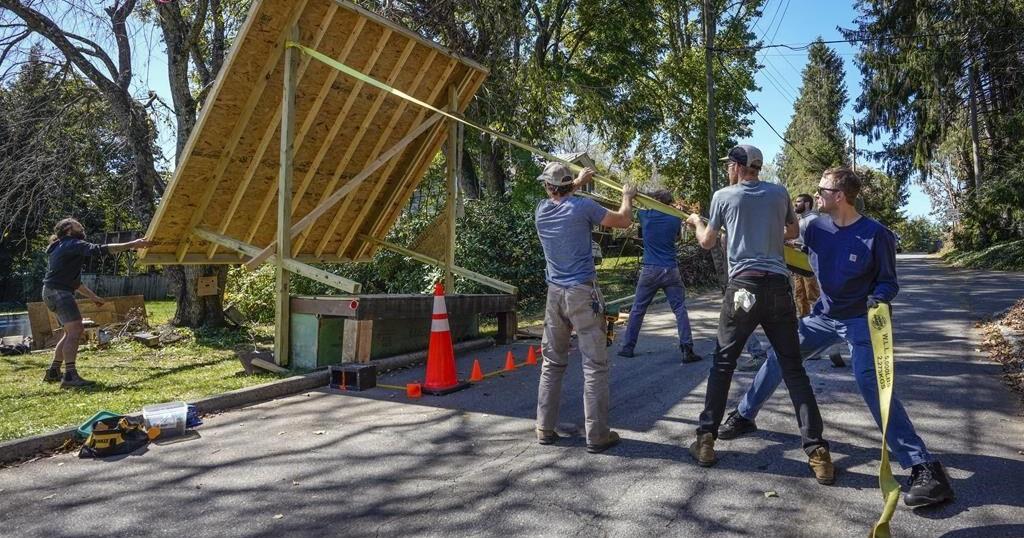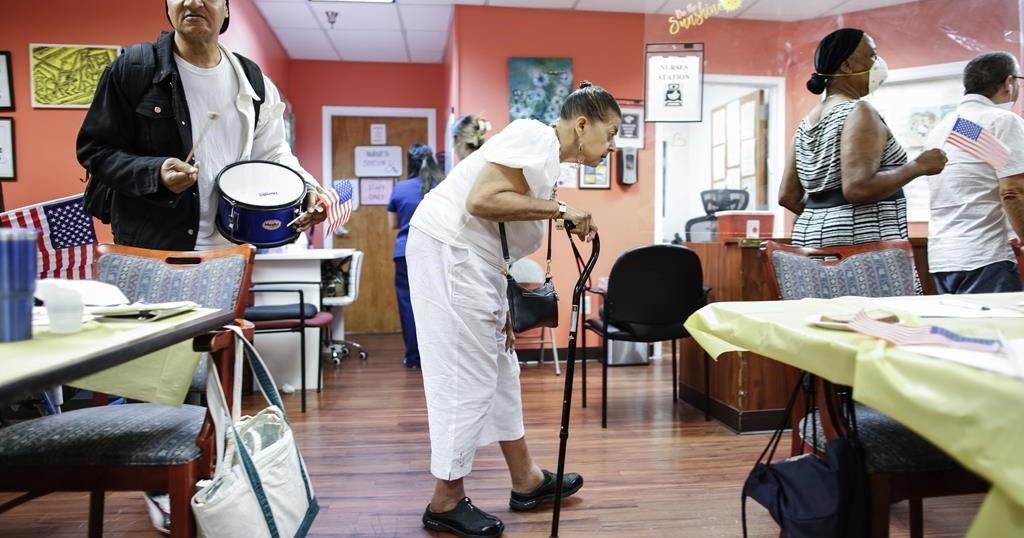Ceremonies, events and protests are being held across Canada to mark the anniversary of a brutal Hamas attack on Israel that triggered the ongoing war in the Gaza Strip.
The Oct. 7, 2023, attack killed about 1,200 people, while about 250 more were taken hostage. About a hundred of them have not returned. It triggered an Israeli counteroffensive in the Hamas-held Gaza Strip that the territory’s health ministry says has left more than 41,000 Palestinians dead. That war is raging on even as hostilities spill into Lebanon and threaten to escalate into a broader regional war.
Here’s the latest on how the anniversary is playing out in Canada. All times are eastern.
———
2:15 p.m.
A group is gathering outside of Montreal’s Concordia University for a planned pro-Palestinian rally and march through downtown.
Dozens of participants, many of whom are wearing keffiyehs and carrying Palestinian flags, are chanting along as a leader with a megaphone chants slogans including “occupation is a crime,” “long live the revolution” and “Viva viva Palestina.”
The McGill and Concordia chapters of Students for Palestine’s Honour and Resistance wrote in joint Instagram posts that the event is intended to call on their institutions to divest from companies tied to Israel’s war efforts and “commemorate the historic breach of the colonial border wall and a year of Palestine’s historic resistance.”
———
1:50 p.m.
A memorial event near McGill University wrapped up without incident this afternoon.
A rabbi led about 150 people in prayer and song, while between 10 and 20 protesters stood at the corner of McGill College Avenue and Sherbrooke Street waving Palestinian flags.
Julian Silverman, a Concordia student, attended the vigil for Israel and said a lot of pain is resurfacing today.
The ceremony lasted about one hour, and Sherbrooke Street in front of McGill University’s lower field was reopened to traffic.
———
1:47 p.m.
Several provincial premiers have joined their voices to a chorus of Canadian politicians mourning those lost in the Oct. 7, 2023 attack.
British Columbia’s David Eby said on social media that the pain and sorrow is still deeply felt in his province, and he stands firmly against violence and its glorification.
Alberta’s Danielle Smith said she mourns the loss of innocent civilians and hopes for the safe return of hostages.
And Quebec’s François Legault said in a French-language post that he wants to see a peaceful resolution to the ongoing conflict.
———
1:30 p.m.
Two Canadians who lost family members in last year’s Oct. 7 attack on Israel have filed a claim in Ontario Superior Court seeking damages under Canada’s Justice for Victims of Terrorism Act.
The statement of claim filed by Ohad Lapidot, the father of Tiferet Lapidot, and Iris Weinstein Haggai – whose parents Judi Lynne Weinstein and Gad Haggai were killed – seeks hundreds of millions in damages.
It lists Hamas, various Palestinian organizations, the leaders of Iran and Syria and several Canadian individuals and groups among the defendants it alleges are in some way responsible or liable for losses and damages caused by the deaths.
None of the allegations in the filing have been tested in court.
———
12:45 p.m.
Under a heavy police presence, more than 100 people have gathered by McGill University for a vigil to remember victims of the Oct. 7 attacks in Israel.
Supporters of Israel, many waving Israeli flags, are on Sherbrooke Street, which is closed to traffic for the event.
They’re within sight of the south entrance to McGill’s lower field, which is blocked off by police.
Posters of Israelis who were taken hostage by Hamas on Oct. 7 are plastered on the fence surrounding McGill’s campus, and at a distance, a few people can be seen waving Palestinian flags.
———
12:42 p.m.
Foreign Affairs Minister Mélanie Joly posted a statement on social media today calling the events of Oct. 7 the worst attack on Jewish people since the Holocaust.
She named Canadian victims of the attack and said nothing can justify the violence and terror unleashed that day.
Joly repeated Canada’s condemnation of Hamas and reiterated calls for the release of hostages.
She says far too many civilians have been killed in the ongoing conflict and Canada is working with its partners to bring peace and security to the Middle East.
———
12:10 p.m.
Families are speaking out in Toronto about loved ones who were caught up in the Oct. 7 attack.
Harel Lapidot spoke at an event in Toronto this morning about his niece Tiferet, a Canadian Israeli woman killed in a massacre at the Supernova music festival in southern Israel.
He says a year later, the family’s grief over the loss of the young woman he describes as their “sunshine” is “getting worse day by day.”
Maureen Leshem also spoke at the event. Her 24-year-old cousin Romi Gonen was among those taken hostage at the festival, and she says the family has received confirmation she is still being held alive.
———
11:30 a.m.
Federal NDP Leader Jagmeet Singh is the latest politician to acknowledge the anniversary of the Hamas attack in Israel.
He says New Democrats and all Canadians mourn with Canada’s Jewish community and all hostages must be returned.
He says his party will continue to work for common humanity, and for justice and peace in the Middle East.
———
10:37 a.m.
Conservative Leader Pierre Poilievre says in marking the anniversary of the attack that the federal Tories unapologetically stand with Israel.
He says in a written statement that hostages must be let go.
Poilievre says Jewish Canadians are facing what he calls “grotesque” antisemitism.
———
10:06 a.m.
Prime Minister Justin Trudeau says his thoughts are with all Israelis and Jewish people, and with the Jewish community in Canada.
Trudeau says in a written statement that Hamas is responsible for setting the region down a path of war and violence, and he condemns Hezbollah and Iran for further instability.
He says the scale of civilian casualties in the past year is heart-breaking and unacceptable and all actors must comply with international law.
Trudeau says his government remains committed to working toward a two-state solution where Israelis and Palestinians can live securely with internationally recognized borders.
———
9:30 a.m.
Police in Canada’s largest cities are stepping up protections, particularly around Jewish and Muslim places of worship and at events being held to commemorate Oct. 7.
A Toronto police van was parked out front of a Hebrew day school this morning along Bathurst Street in one of the city’s most recognizably Jewish neighbourhoods.
On the corner, a large poster called for the return of hostages.
———
9:02 a.m.
Premier Doug Ford is expressing his condolences for those whose loved ones were killed or taken hostage in the Oct. 7 attack.
He says in a written statement that he is vowing to combat antisemitism and hate in the province.
He says his government will stand up against hate wherever it is found and work to foster understanding, unity and respect.
———
This report by The Canadian Press was first published Oct. 7, 2024.























